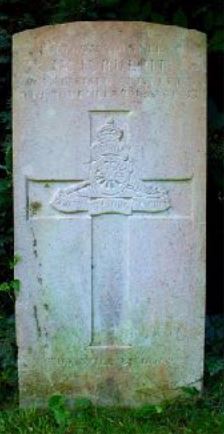393rd Battery, Royal Field Artillery

William Henry Bulpit was born in 1881 at Catherington, near Horndean in Hampshire. His parents were Charles Bulpit (1848-1930) and his wife Ann Elizabeth, who also appeared to have Bulpit as her maiden name (1855-1936). The couple appeared to have had two children, William and his brother, George, born in 1886.
By 1901 the family had moved to Meysey Hampton, near Cirencester, where Charles Bulpit was employed as a domestic gardener and likewise his son, William, now aged 19.
On 30 June 1906 William married local girl Ada Annie Tombs, at Meysey Hampton Parish Church and at the time of the 1911 Census they lived at The Lodge, Marston Hill, Fairford and William’s occupation was still as a domestic gardener. It would appear that their first born child died prior to 1911; a daughter, Evelyn Rose, was born on 18 October 1912.
It appears that no Army Service or Pension Record File has survived for William. The Soldiers Died in the Great War volumes state that he enlisted at Borden, Hampshire. There is no evidence of a Medal Index Card, which indicates that he served other than in the UK and he would appear to have been posted, initially, as 176571 Gunner Bulpit, to the 393 Battery, Royal Field Artillery. It has not proved possible to discover the location of this unit, nor its function but it is likely to have been a reception unit for new recruits. It also seems likely that William was conscripted, under the Military Service Act 1916 and was probably mobilised sometime in 1917. He would then have been aged in his mid thirties and was likely not to be considered sufficiently fit for front line service. This may account for his subsequent transfer, on an unknown date, to 699 Agricultural Company, Labour Corps. As their name suggests, Agricultural Companies assisted UK farmers with harvesting and food production.
Towards the end of the war, 699 Agricultural Company must have been located somewhere in Kent, as we know from the Register of Soldiers’ Effects that he died at Rolvenden, Kent Voluntary Aid Detachment (VAD) Hospital: a recently released Pension Record Card gives the cause of death as ‘influenza and rheumatism contracted on active service’. He was very likely a victim of the ‘Spanish Flu’ pandemic, raging at the time. Death occurred on 9 November 1918, when he was aged 37 and burial, in the churchyard of St Mary’s, Meysey Hampton, took place on 16 November. A standard CWGC headstone (which bears the Royal Artillery badge) now marks his grave and he is commemorated on the Great War Memorial Tablet inside Meysey Hampton Parish Church.
His widow, Ada, later lived at Hill Side, Meysey Hampton; she appears not to have re-married and lived in the area until her death in 1958.
Researched by Graham Adams 2 January 2021
